Code is law, but the Real Law may be Coded into the Virtual Community
Following the last post on the 10 websites that lead you understanding Cinternet, I’d like to share more specific observations to two of them. One is Douban.com , a “2.0” site but unique from other web 2.0 sites in English web sphere, and the other is Tianya.cn, a huge BBS that is also different from the western style of discussion groups. From them, one may find the law (I mean the living law, not definitely the legislations) has changed the code.
1. Douban.com
Douban.com is a unique website that I can not find the counterpart in the English web sphere. It has launched a English site but now suspended.
Named after a spice used in Szechuan cooking, Douban allows Chinese consumers to share, tag and browse through one another’s collection of books, music, and movies. Douban has very good infrastructure which provide the aggregation of the users every act (tag a book after read it or just “want to read”, write a review, rank a movie … all the user’s acts can be aggregated and published to his/her friends’ first page. and each act can be set hidden from the public). According to a user’s acts, douban “guesses” the new books, movies and musics for the user, and recommend the user to other users. Douban released a “Douban 9” channel, which is a social aggregator that the users may use it as an RSS reader, but more openly to the others. Recently, douban launched a “Douban Listen” (douban.fm) channel, which is similiar to Pandora.com.
The contents in Douban are mostly user generated. However Douban is distinct from Youtube: only comments to the items (books, movies and music albums) are posted on the website. In each item’s page, Douban provides the links to the online bookstores (including Amzon’s Chinese site). The prices are easily compared in an item’s page.
Douban’s biggest distinction from the SNS (like facebook) is: it is not a real-name network. Therefore, it is mainly not for social and personal networking, but for public expression. Besides the review tab in each item’s pages (which are now becoming the most useful resource for Chinese young people’s when they are about to watch a movie or buy a book), users can also establish groups and invite others join. There are thousands of groups and thousands of entries are posted every day. Because the groups are established by the users, one may see many interesting ones. Take the keyword of “man” as an example, there are “man-should-cook” group, “we-love-very-old-man” group, “not-answering-phone-man-should-die” group and more than 370 other ones. Because most users are in anonymous, discussions are very interest-oriented and open.
If there were no censorship, Douban might be a good platform to form a classic “public sphere”. However, douban enforces a very strict self-censorship policy. Any thread that may “threat the operation of douban in China” will be hidden (only the author can read). The groups include too much “in-harmonious” topics will be closed by douban’s staff – or be hidden and only the members of the group may read those threads. It is obvious that Douban’s operator does not want this websited be involved into any political debate.
2. Tianya.cn
Tianya (means skyline) is the most popular and most crowded online forum in China. And as for the number of the threads and the accounts, maybe in the world. It’s traffic is ranked No. 90 in the world (Alexa). It is the symbol of the prosperous BBS culture in China
Two mechanisms keep Tianya being survival and flourishing:
One is that it has a huge group of volunteer forum-board masters who are in charge of deleting/hiding the defamatory, dissenting and – most specially – inappropriate posts (means the threads should not be posted in specific forum board, like an essay on travel is posted to a forum boad on the gourmandism). Besides, the board masters also have the right to deny some ID’s posting, the right to make a post highlighted, etc. The board masters are mostly the famous IDs (in many cases most of users don’t know who the people is in real world), they are famous and reliable only because of their reputation established in Tianya.
The other is the un-deletable and un-editable mechanism. No one can delete/edit his/her own posts at the forum boards, even a board master can only manage the posts at his/her board – as a user in other boards, he can do nothing but posting new threads as a normal user if users think a board master is not appropriate, they may leave the complaint at the manage board – and if those complaints are reasonable, the higher webmaster may decide to suspend the board master’s authority – just like the mechanism of “petition” in China’s real life.
In Tianya, no one can establish a separate forum/group. All the forums are set by the general webmaster. Users may apply for establishing a new board by posting threads to the “Manage board”, but only the website can make a new board. The ecology of Tianya can be described a pyramid one.
Short conclusion:
Neutrally speaking, the different law in various jurisdiction diversified the digital code, as well as the Internet. When a society is digitized, the Internet is also formulized by the law in such society. “Cinternet” is not only a concept of physical “walled part” of the Internet”, but may be another “sphere” of the Internet, which isolated from other spheres mentally, systematically, and even institutionally – It’s not absolutely a bad thing, or a good one. It may be just an existence.
